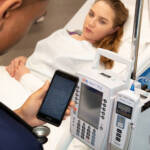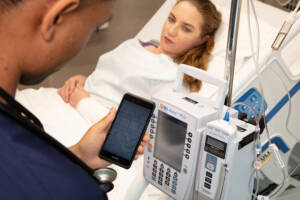3 Ways to Reduce Unnecessary Hospital Days with One Mobile Healthcare Solution

Estimated Reading Time: 3 minutes, 10 seconds
 It’s no secret that hospitals across the US are facing significant staffing shortages. According to the American Hospital Association, the US will face a shortage of up to 124,000 physicians by 2033 and must hire 200,000+ nurses yearly to meet demands. But that is not the only critical – and costly – problem facing US healthcare systems. A 2024 Becker’s Hospital CFO Report indicates that capacity issues are rising, leading to unnecessarily longer stays, poor patient experiences, and higher costs that impact the bottom line.
It’s no secret that hospitals across the US are facing significant staffing shortages. According to the American Hospital Association, the US will face a shortage of up to 124,000 physicians by 2033 and must hire 200,000+ nurses yearly to meet demands. But that is not the only critical – and costly – problem facing US healthcare systems. A 2024 Becker’s Hospital CFO Report indicates that capacity issues are rising, leading to unnecessarily longer stays, poor patient experiences, and higher costs that impact the bottom line.
Though it might sound counterintuitive, according to the February 2024 Kaufman Hall report featured in Becker’s, shorter hospital stays lead to better financial performance. Efficiently moving patients through the hospital turns over beds faster, meaning the hospital incurs fewer unnecessary costs. Inefficient hospital discharges cost billions. In California alone, avoidable costs reach $3.25B annually, and an estimated 7.5 million emergency department hours are wasted. Conversely, efficient discharges can save a 425-bed hospital $20 million annually.
So, what can be done to reduce the problems leading to unnecessarily longer stays?
1.) Streamline Administrative Processes: Healthcare staff need a tool to quickly access email and the Internet, patient records, and other critical healthcare applications for bed management, patient transportation, pharmacy, phlebotomy, EVS (environmental services), and more. This would provide instant, real-time access to critical workflow information, enabling the faster transport of patients throughout the hospital for tests, imagery, therapy, or other care. In turn, discharge can be alerted when a patient is cleared to leave, which triggers janitorial staff to turn a room over for the next patient.
Ideally, this solution would allow frontline workers to forego using workstations or relying on paper to keep track of workflow, saving critical time and reducing the risk of errors.
2.) Improve Communication and Collaboration: Hospitals traditionally rely on overhead paging, nursing stations, and pagers for communication, creating a noisy environment and hindering staff from receiving critical communications clearly. Transitioning from paper to Electronic Health Records (EHRs) requires a secure, accessible, and mobile-friendly solution.
At-home care is also becoming critical to combat bed capacity issues. Care that previously would have required additional days in the hospital can now be done at home. Doctors and nurses need a tool to help them communicate with their patients at home to ensure they are still receiving exceptional care.
3.) Enable Better Patient Care: More efficient administrative processes and improved communication and collaboration lead to faster, better patient care. By replacing loud overhead paging systems with a mobile solution, the hospital environment becomes quieter and more peaceful, which benefits patient healing. Response times become faster because critical staff can receive and triage alarms immediately or pass care on to the most appropriate team member to address; faster care in emergencies can lead to better patient outcomes. With a mobility solution – ideally one with an integrated barcode scanner – not only do nurses and clinicians save valuable time having to go to a nurses’ station to make calls, but they no longer need to locate and transport workstations on wheels to scan meds and input information into a patient’s record.
3 Goals, One Solution
Cut down unnecessary hospital stays, improve patient outcomes, and empower clinicians to do more while carrying less. The Versity 97 healthcare smartphone from Spectralink is built for demanding healthcare environments, starting with its unbreakable toughness. Ditch the bulky cases – this device withstands endless cleanings and drops, and has undergone rigorous durability testing that far exceeds industry and competitive standards. Blazing-fast processing lets you power through healthcare apps with ease, while unmatched AI-enhanced voice quality ensures every critical word is heard. (See our video to witness the crystal-clear difference!)
Seamless collaboration leads to improved care. Secure texting and EHR integration with leading systems like Oracle and Epic keeps patient information flowing securely. Respond to patient alarms instantly with real-time nurse call integration through Rauland and West-Com. The Versity 97 is also Android Enterprise Recommended, giving you industry-leading security on a platform you know and trust.
Extend exceptional care beyond the hospital walls. Remote monitoring allows doctors to connect with at-home patients via secure video calls and text messaging. Crystal-clear, secure communication ensures every interaction is efficient and HIPAA-compliant.Finally, the Versity 97’s proprietary SAFE application and native safety features, including a one-touch panic button and man-down response, ensure unmatched safety and faster response in emergencies or critical care situations.
The Versity 97: a revolution in healthcare efficiency.
Contact our team today to learn how to protect your bottom line while reducing unnecessary hospital days for patients.
Related Blogs:
Improve Healthcare Outcomes and Maximize Your Tech Investments
Top 10 Reasons Nurses Need A Spectralink Versity Smartphone
Spectralink Refines Mobile Workforce Productivity and Communication with the Introduction of the Versity 97 Series Enterprise-Grade Smartphones
